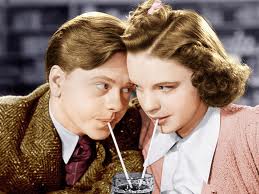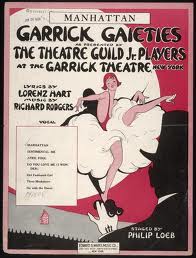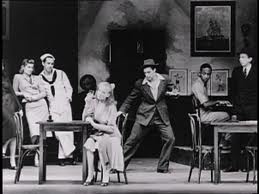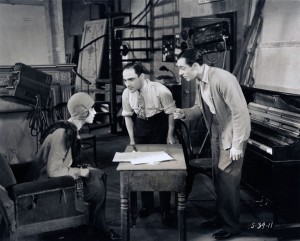In the 1930s, Rodgers and Hart were a premium writing team with Richard Rodgers composing masterful melodies and Lorenz Hart writing some of the most clever and at times ephemeral lyrics Broadway audiences would ever hear. Rodgers provided tunes that helped define mood, character, and situation, while Hart offered poetic lyrics that transformed into poetry. The team was hugely popular.
Hits Galore
The writing team had no lack of hits. “Falling in Love with Love,” “Here In My Arms,” “My Heart Stood Still,” “Ten Cents a Dance,” and “Dancing on the Ceiling” were just a few of their hits.
Cleverness abounded in songs such as “Bewitched, Bothered and Bewildered” and “Manhattan.” “Manhattan,” which was written in 1925 for the Garrick Gaieties, offered audiences a lyric that turned phrase after phrase into pure Broadway gold and that helped make the song a standard.
How Clever Can You Be?
As a composer, Richard Rodgers was a tunesmith who knew how to create hits. In working with Lorenz Hart, he became a composer who provided the foundation for a poet who mastered the nuance of language.
The lyrics for Manhattan starts by noting that instead of bothering to go away away, it’s best to stay on the Island of Manhattan. It reads:
“Summer journeys
To Niag’ra
And to other places
Aggravate all our cares.
We’ll save our fares.
I’ve a cozy little flat
In what is known as old Manhattan.
We’ll settle down
Right here in town.”
Hart then weaves an intricate picture of exactly what is to be enjoyed on and around the island. He writes:
“We’ll have Manhattan,
The Bronx and Staten
Island too.
It’s lovely going through
The zoo.
It’s very fancy
On old Delancey
Street, you know.
The subway charms us so
When balmy breezes blow
To and fro.
And tell me what street
Compares with Mott Street
In July?
Sweet pushcarts gently gliding by.
The great big city’s a wondrous toy
Just made for a girl and boy.
We’ll turn Manhattan
Into an isle of joy.”
The lyrics is a joyful tour of everything wonderful the city and its environs have to offer a couple in love as it finds great joy in simplicity and nuance. There’s a decided focus on city life (“the subway charms us” and “sweet pushcarts gently gliding by”) and on nature (“balmy breezes blow”). Hart makes what could be annoying or mundane elements magical in his lyric and thus defines the love the boy and girl possess for one another.
The 1930s
In the 1930s, the writing team seemed to be unstoppable as they created some of their greatest hits, including “Isn’t It Romantic?,” “My Funny Valentine,” “Blue Moon,” and “The Lady is a Tramp.” Their song “Where or When,” which premiered in 1937, has one of the most haunting love lyrics ever written.
From 1936 through 1940, Rodgers and Hart wrote nine Broadway shows, including On Your Toes (1936), Babes in Arms (1937), The Boys from Syracuse (1938), and I Married an Angel (1938). In 1940, they created what may have been their most ambitious effort, Pal Joey.
The main character in Pal Joey, which was played by a young Gene Kelly, is an opportunist and a rogue. He’s not your typical musical comedy leading man. The primary female character is a middle-aged, rich cougar named Vera who enjoys men for what they have to offer physically. She is married.
Pal Joey ran for 10 months on Broadway after receiving mixed reviews. The score included the romantic tune “I Could Write a Book” and the racy and witty “Bewitched, Bothered, and Bewildered.”
The only musical the team wrote after Pal Joey was By Jupiter, which ran for a little over a year. It starred Ray Bolger. In 1943, due to Hart’s alcoholism and the friction it created with Rodgers, the writing team broke up. Hart died within the year.
Rodgers started writing with Oscar Hammerstein and together they created Oklahoma!, Carousel, South Pacific, The King and I, Cinderella, and The Sound of Music.
Lasting Legacy
Rodgers and Hart were hit makers in the mid 1920s and through the 1930s. Their musicals are not as sturdy as those created by Rodgers and Hammerstein. One reason for this is that Hammerstein was an accomplished librettist and lyricist and that meant that he was able to control the musicals he created with Rodgers. Hart, who in many ways was a better lyricist than Hammerstein, did not write librettos and that resulted in the team of Rodgers and Hart having less control. Still, over the course of their partnership, Hart with Rodgers wrote a catalogue of over 500 songs.





